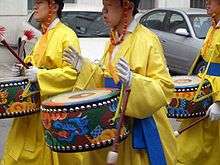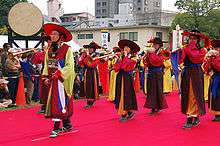Daechwita
| Daechwita | |
 | |
| Korean name | |
|---|---|
| Hangul | 대취타 |
| Hanja | 大吹打 |
| Revised Romanization | daechwita |
| McCune–Reischauer | taech'wit'a |

Daechwita (literally "great blowing and hitting") is a genre of Korean traditional music consisting of military music played by wind and percussion instruments, generally performed while marching. Instruments used include nabal (brass horn), nagak (seashell horn), and taepyeongso (shawm), with jing (gong), jabara (cymbals), and yonggo (hangul: 용고; hanja: 龍鼓; drum painted with dragon designs and played with sticks).
This style of Korean military music is often used in the reenactment of the Guard Changing Ceremony at Seoul's Gyeongbok Palace, as well as in Deoksugung Palace. A special daechwita today is under the service of the Traditional Guard Unit, Republic of Korea Army, and is the only one that also has the Ulla (small tuned gongs) in its instrumentation. This is the same case for traditional Korean bands outside the homeland, which also have a pungmul marching percussion battery (with kkwaenggwari, janggu and Buk drums) at the rear with distinguishing uniforms between the two ensembles. Few modern bands sport bass drums with the kwaennggwari and janggu as part of their instrumentation.
Chwi-ta

Chwi-ta (or choi-ta) is the name of the military music played in military processions and on such occasions as when the gates to military headquarters were opened or closed.